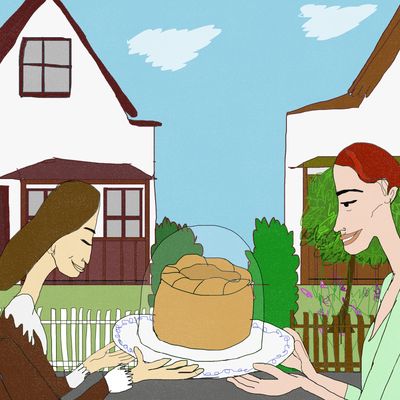
New York subscribers got exclusive early access to this story in our Brooding newsletter. Sign up here to get it in your inbox.
Conservatives are years deep into a period of raging nostalgia for a fake past, the historical details of which most people have a sketchy grasp on at best. They’re not nostalgic for the ’50s as it actually was — a time of government largesse, with huge spending on education and housing — but the ’50s as it exists in the imaginations of many white Americans: as the peak of “normal” white American culture. This is where our ideas about what a “typical American family” looks like tend to originate. The very concepts of the nuclear family, of “family” as a consumer category, of the roles that each member of a family are understood to play (“girl dad,” anyone?): All of this flows from mass media of the 1950s. Even though family life today bears little resemblance to that time, the aesthetic aura of the 1950s family has had diabolical staying power in our popular culture, a recent example being, of course, the whole “trad” thing.
But deep readers of history probably know that the opposite is true: The 1950s were the most abnormal decade in American history so far — a total aberration? The destruction of Europe and Japan during the war was a huge boon for the American economy, but that circumstance was necessarily temporary. Between 1945 and 1960, the United States’ GNP grew by 250 percent, and per capita income grew by 35 percent. The white middle class exploded; between 1957 and 1967, the number of salaried workers went up by 61 percent.
There was no precedent for the brief period post–World War II during which white American families — and white families only — organized themselves into upwardly mobile little suburban units, and the conditions that made that transformation possible were so dramatic and so specific that we will almost certainly never see them again.
Even the ideal of the stay-at-home ’50s housewife is a chimera. Women had been joining the workforce in steadily increasing numbers since the turn of the 20th century, and in fact they continued to do so through the 1950s. Between 1940 and 1960, there was a 400 percent increase in the number of working mothers. Author and historian of family life Stephanie Coontz reports that by 1960, women with school-aged children accounted for about a third of all working women.
This is just one of the many insights contained in Coontz’s The Way We Never Were, an indispensable cultural history of family life in America that is as relevant and illuminating today as it was when it was first published in 1992. Coontz’s work has become required reading for students in fields across the social sciences, and she’s still working, into her 80s — she’s finishing up a new book, to be titled For Better and for Worse, about the history of marriage.
I have recently been revisiting her work for emotional ballast. Reading history can provide that, and I don’t just mean in an escapist, delusional, let’s-pretend-the-calm-voices-on-NPR-mean-everything-is-okay kind of way. I have been looking for ways to understand the two-dimensional nostalgia of MAGA as an ideology, in particular as it imagines family life.
Coontz wrote The Way We Never Were in the midst of the political mobilization around “family values” during the late ’80s and early ’90s, the late Reagan-Bush père years. The dominant nostalgic fixation of the time was on the importance of two-parent families in defending against social devolution of all kinds. The crack epidemic, street gang violence, the slacker posturing of young Gen X — all of this and more was being blamed on the rise of “broken homes,” which was the cultural scapegoat of the time, an analog for today’s “woke culture.” During this era, David Duke, a neo-Nazi former Klansman, and Pat Buchanan, a Christian nationalist and “paleoconservative” (woof), ran not-unserious bids for presidential candidacy.
Meanwhile, the divorce rate was approaching 40 percent in 1992 and single working mothers were being gradually destigmatized, through TV shows like Murphy Brown and Kate & Allie. (The latter was a show about two divorced best friends who move in together to raise their kids — a premise ripe for a remake, I’m thinking Ali Wong or Busy Philips.)
It was during this era that the wistfulness for a fake 1950s past first emerged. What family-values conservatives really wanted to reinforce was the privatization of family life, and the maintenance of autonomous, isolated economic and social nuclear family units, where patriarchy could rule unchecked, with dependent women and children safely contained within “traditional” social and economic roles.
But conservatives didn’t have to do much arm-twisting; the American family had already become incredibly inward-facing during the decades following the Second World War, and they didn’t need convincing to stay that way. We still don’t. Reading The Way We Never Were feels at times grimly up-to-date: Despite all the notable progress social movements have made since 1992, it feels like one fundamental problem — the way family life can exacerbate social isolation, rather than ease it — has only gotten worse.
Coontz describes how the 1950s saw the emergence of the “emotionally expressive” family — the family in and through which we are meant to have all of our emotional needs met. It’s how we expect to feel love and belonging, it’s where we acquire morality, self-esteem, ambition — everything. Starting in the ’50s, the idea that these qualities might be developed outside the home, in one’s community, has sat a bit uncomfortably even for liberal people. This was the beginning of the end for clubs and associations that made up a huge part of social life in previous eras — why would you need any of that, when you’re now the proud owner of your own suburban home and 2.5 kids? To this new middle class, community interdependence smacked of dependence on public programs — poor-person shit.
In the decades since, nothing in this regard has changed. As parents, we are supposed to be able to instill in our children everything they will ever need, ourselves. But this self-reliance is a social invention, one born when American private life was on steroids thanks to a raging economy. And yet, if the “perfect American family” and its obediently upward-trending birthrate was a brief aberration, if it has nothing much to do with the way any culture on earth has ever actually lived, why can’t we quit it?
I called Coontz up at her home in Washington State to find out if she agrees with me that fake nostalgia is a sickness with no cure, and with the equanimity of any eminent historian worth their title, she calmly disagreed.
“I think that we have changed quite a bit on the family side of it,” she said, reflecting on what’s changed since 1992. “There’s a lot more tolerance for single-parent families, for divorce. And in some ways, contrary to what conservatives would say, our standards for marriage have been raised. We consider it to be a stronger commitment than we did in the past. People are open to consensual open marriages, and they’re open to divorce, but they are very, very down on the idea of lies and mistreatment.”
Coontz is generally optimistic about the direction that family life is headed: Unhappy marriages are much less tolerated than they once were. Couples are talking through sharing child care and house work, and even if domestic equality is elusive, it’s on the table. (Many mothers I know would disagree that simply talking about domestic inequality is a meaningful step toward actually enacting it — to them, anything less than equality is capitulation. To this, Coontz would counsel taking comfort in a view slightly longer than one generation: “Both history and current studies show us that we can change.”)
But all this effort and expectation that we put into our family relationships is a double-edged sword, according to Coontz. Couples spend so much time together, trying to fulfill their obligations correctly, that they are losing the social connections they need to stay sane.
“Date nights are the worst marriage advice that I’ve ever heard of,” she said. The tyranny of one-on-one time, according to Coontz, is bad for everyone.
“We have to understand that it’s a win-win situation if we cultivate our single friends and our single lives and our single skills,” she continued. “It brings new life to our marriage, but it also protects us in two ways. It protects us against asking too much from our marriage, and if we leave our marriage, we already have social networks, so we don’t have to start all over.”
But the convenience structures of everyday life, from streaming to DoorDash, conspire to keep us more isolated from our communities than we could be, and more enmeshed in family structures that continue to resemble the historical anomaly of the 1950s nuclear family.
In the late ’70s, at the exact same time that conservative think tanks began rolling out “family values” talking points, experts began to warn against the risks of using the family — the private sphere — as a focus for solving public problems (like drug addiction, domestic violence, or what at the time was called “social apathy”). In The Way We Never Were, Coontz quotes a scholar who wrote in 1979 that the country had entered “a very private age in which people turn inward to themselves, their families, and various consolations of escape, nostalgia, science fiction, food, and jogging.” This could have been written yesterday, except now we don’t jog — we train.
If conservatives are hung up on re-creating 1950s families by forcing women to bear children and forcing children to obediently adhere to a two-gender binary, liberals are doing their own ’50s-era pantomime, too, by continuing to believe that the nuclear family is the most sound and respectable unit of social organization. It’s easy to worry about the window dressing of fake nostalgia — the tradwives, the birth-rate discourse. What’s harder is acknowledging that these illusions are behind our own expectations too.
More From This Newsletter
- Is Annoyance the Most Romantic Emotion?
- Should Kids Really Learn About Getting Rich?
- Is an Overcrowded House Such a Terrible Thing?


